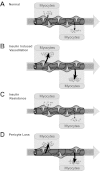The role of blood vessels, endothelial cells, and vascular pericytes in insulin secretion and peripheral insulin action
- PMID: 20164242
- PMCID: PMC3365844
- DOI: 10.1210/er.2009-0035
The role of blood vessels, endothelial cells, and vascular pericytes in insulin secretion and peripheral insulin action
Abstract
The pathogenesis of type 2 diabetes is intimately intertwined with the vasculature. Insulin must efficiently enter the bloodstream from pancreatic beta-cells, circulate throughout the body, and efficiently exit the bloodstream to reach target tissues and mediate its effects. Defects in the vasculature of pancreatic islets can lead to diabetic phenotypes. Similarly, insulin resistance is accompanied by defects in the vasculature of skeletal muscle, which ultimately reduce the ability of insulin and nutrients to reach myocytes. An underappreciated participant in these processes is the vascular pericyte. Pericytes, the smooth muscle-like cells lining the outsides of blood vessels throughout the body, have not been directly implicated in insulin secretion or peripheral insulin delivery. Here, we review the role of the vasculature in insulin secretion, islet function, and peripheral insulin delivery, and highlight a potential role for the vascular pericyte in these processes.
Figures


References
-
- Mokdad AH, Bowman BA, Ford ES, Vinicor F, Marks JS, Koplan JP 2001 The continuing epidemics of obesity and diabetes in the United States. JAMA 286:1195–1200 - PubMed
-
- Diamond J 2003 The double puzzle of diabetes. Nature 423:599–602 - PubMed
-
- Aird WC 2007 Phenotypic heterogeneity of the endothelium. I. Structure, function, and mechanisms. Circ Res 100:158–173 - PubMed
Publication types
MeSH terms
Substances
Grants and funding
LinkOut - more resources
Full Text Sources
Medical
Molecular Biology Databases

